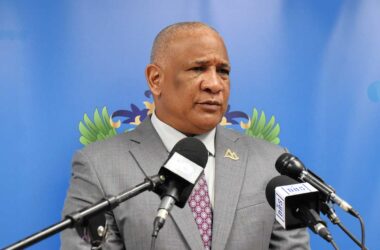Analysts Say Testing Year Ahead.
THE Caribbean’s huge debt burden continues to be among the region biggest problems, resulting in persistently low growth and development in most Caribbean territories. However, there still remain some bright spots, Saint Lucia included.
That’s according to VangieBhagoo-Ramrattan, who leads the research team at First Citizens Investment Services, when she presented at First Citizens’ Market Outlook seminar at Bay Gardens Inn on Thursday.
![Image: (From left to right) Richard Peterkin, First Citizens’ Sana Ragbir and VangieBhagoo-Ramrattan, and Invest Saint Lucia’s Alana Lansiquot-Brice at Tuesday’s market outlook seminar. [PHOTO: Stan Bishop]](https://www.thevoiceslu.com/wp-content/uploads/2017/02/Richard-Peterkin.jpg)
St. Kitts and Nevis came in second with an estimated 3.5%, thanks to its construction and tourism sectors and the spinoffs from its Citizenship By Investment (CBI) programme. However, commodity exporters, Trinidad and Tobago and Suriname, posted the worst figures, with over 4% and 10% negative growth.
Regional growth is expected to be around 2.2% this year, with the IMF projecting a 1.2% growth in Saint Lucia. Last year, the Saint Lucian economy declined by 0.6% despite a marginal uptick in the banana sector which contributed to a significant increase in the agriculture sector, which took a battering from Tropical Storm Matthew last September, resulting in nearly 80% of agricultural lands being affected.
Nearly 4 million Caribbean immigrants live in the United States and total remittances to the Caribbean from that demographic via formal channels amounted to an estimated US$10 million last year. In 2014, the World Bank estimated that remittances accounted for nearly 8% of the region’s total Gross Domestic Product (GDP).
However, the concern is that should the Trump administration follow through on its campaign rhetoric of cutting the H-B1visa programme “with no exception”, a drop in remittances is likely. That special visa allows U.S. employers to recruit and employ foreign professionals in specialty positions in the U.S. for a specific time period.
According to Bhagoo-Ramrattan, economic activity in Saint Lucia up to the third quarter of last year declined marginally due to poor performances of the hotel and restaurant sector and manufacturing and total visitor arrivals fell by 11.6% compared to a 7.8% increase the previous year.
There was some improvement in the construction sector, primarily in the tourism sector, among them Royalton, Harbor Club Hotel and the new Courts store, to name a few. However, private sector investment dropped, resulting in a 15% decline in capital expenditure.
Bhagoo-Ramrattan said labour productivity, which is the ratio of total labour compensation per hour worked to the output produced per hour worked, was also a major factor for the Saint Lucian economy.
“Labour productivity since 2010 has been on the decline. The unit labour cost determines the competitiveness and is the average labour cost per unit of output produced, so a rise in the labour cost (that is) higher than the rise in productivity is going to erode your country’s competitiveness,” she explained.
She also cited unemployment as another concern for Saint Lucia, saying that “up until 2015, the unemployment rate was about 24.1%, which was very high. What was even more worrying was the youth unemployment rate which was about 40%.”
Government’s mounting debt, too, continues to be among those major challenges for Saint Lucia. From 78.1% in 2014, the debt-to-GDP ratio fell to 77.8% in 2015 but rose to 82.9% in 2016 and expected to rise to 85.4% this year.
Richard Peterkin, partner in charge of tax and transaction services at Grant Thornton Windward Islands, also presented at the seminar, saying government’s impending four-year plan needed to be ambitious enough to offset the poor performances in the economy of late.
“Quite frankly, we do need to try something out of the box. We need to push the envelope. We need to do something different because all these islands have been doing the same thing year after year and getting nowhere. So if we’re going to get out of that spiral of low growth, high deficits, when we can’t borrow anymore and we’re not getting foreign direct investment, so something needs to change.”
According to the World Bank’s 2017 Doing Business Report, Saint Lucia slipped from 78th to 86th among the 190 countries ranked. According to the report, the decline was attributed mainly to the island’s ranking slipping from 29th to 56th in the Getting Electricity category. Saint Lucia also ranked over 100th in three other categories, namely Getting Credit (157th), Resolving Insolvency (114th) and Registering Property (104th).


![Image: (From left to right) Richard Peterkin, First Citizens’ Sana Ragbir and VangieBhagoo-Ramrattan, and Invest Saint Lucia’s Alana Lansiquot-Brice at Tuesday’s market outlook seminar. [PHOTO: Stan Bishop]](https://thevoiceslu.com/wp-content/uploads/2017/02/Richard-Peterkin.jpg)










![Lisa Hunt - Chief Nutritionist [Photo credit : MOA]](https://thevoiceslu.com/wp-content/uploads/2025/12/Lisa-Hunt-Chief-Nutritionist-feat-380x250.jpg)

